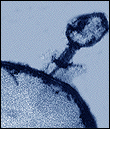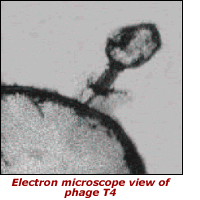Last updated: April 23, 2013
1952: Genes are Made of DNA
1952: Genes are Made of DNA
 Alfred Hershey and Martha Chase showed that only the DNA of a virus needs to enter a bacterium to infect it.
Alfred Hershey and Martha Chase showed that only the DNA of a virus needs to enter a bacterium to infect it.
Their experiment provided strong support for the idea that genes are made of DNA. They firmly restated the conclusion that Avery, et al. had more tentatively proposed in 1944.
Electron microscope images showed that a bacterial virus - bacteriophage T4 - attaches to a bacterium to infect it. Hershey and Chase figured that the virus transferred genetic material into the bacterium to direct the production of more virus.
They knew that bacteriophage T4 was made of protein and DNA. They also knew that proteins contain sulfur atoms but no phosphorus, while DNA contains a great deal of phosphorus and no sulfur. They used radioactive sulfur and phosphorus to label and, so, distinguish viral proteins from viral DNA. After allowing labeled viruses to infect bacteria, they observed that the radioactive phosphorus enters the bacteria while the radioactive sulfur always remains outside.
More Information
Reference:
Hershey, A.D., Chase M., 1952. Independent functions of viral protein and nucleic acid in growth of bacteriophage. J. Gen. Physiol, 36:39-56. 1952. [PubMed]

« Previous Event | Next Event »
